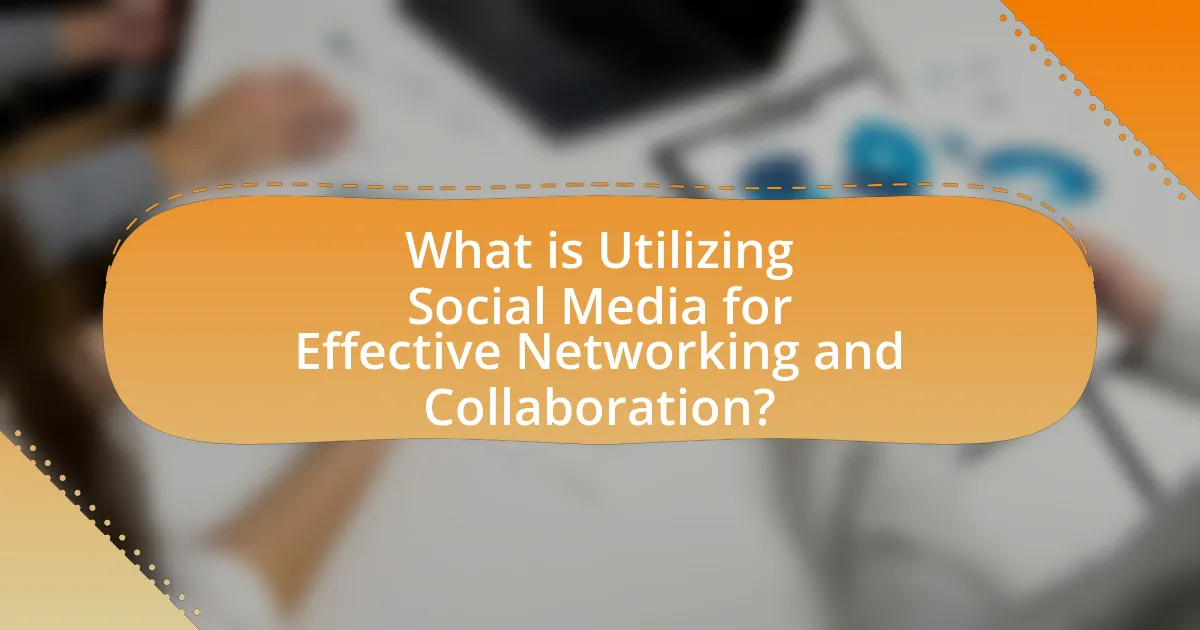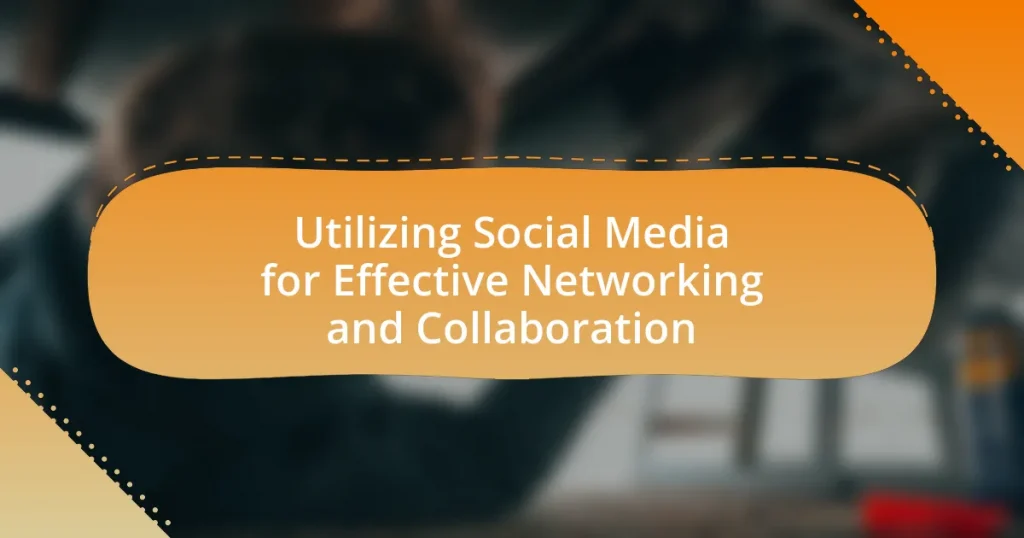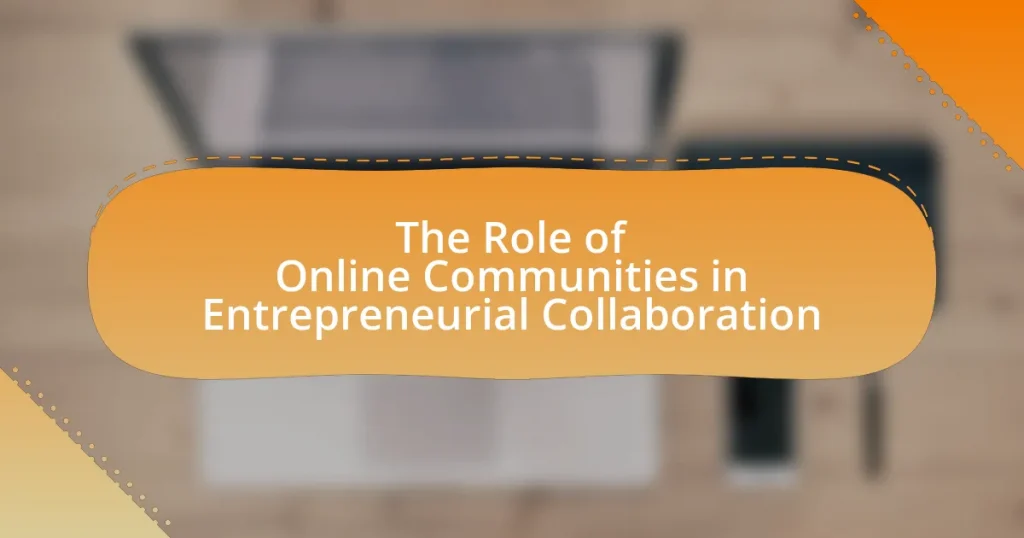Utilizing social media for effective networking and collaboration involves leveraging platforms such as LinkedIn, Twitter, and Facebook to build professional relationships and enhance teamwork. The article explores how these platforms facilitate real-time communication, resource sharing, and the expansion of professional networks, with 70% of professionals using social media for networking. Key features that enhance networking include connectivity, accessibility, and collaboration tools, while challenges such as information overload and privacy concerns are also addressed. Best practices for maintaining professional relationships and measuring networking success are discussed, along with practical tips for improving engagement and collaboration through social media.

What is Utilizing Social Media for Effective Networking and Collaboration?
Utilizing social media for effective networking and collaboration involves leveraging platforms like LinkedIn, Twitter, and Facebook to build professional relationships and facilitate teamwork. These platforms enable users to connect with industry peers, share knowledge, and collaborate on projects in real-time, enhancing communication and resource sharing. According to a study by the Pew Research Center, 70% of professionals use social media for networking, highlighting its significance in modern professional environments.
How does social media facilitate networking and collaboration?
Social media facilitates networking and collaboration by providing platforms that enable individuals and organizations to connect, share information, and collaborate in real-time. These platforms, such as LinkedIn, Twitter, and Facebook, allow users to build professional relationships, join interest-based groups, and participate in discussions, thereby expanding their networks. According to a 2021 survey by the Pew Research Center, 70% of adults in the U.S. use social media to connect with others, highlighting its role in fostering communication and collaboration. Additionally, tools like Facebook Groups and LinkedIn’s networking features enable users to collaborate on projects, share resources, and exchange ideas, which enhances collective problem-solving and innovation.
What are the key features of social media that enhance networking?
The key features of social media that enhance networking include connectivity, accessibility, and real-time communication. Connectivity allows users to build and maintain relationships with a diverse range of individuals and organizations, facilitating professional networking opportunities. Accessibility ensures that users can engage with others from anywhere in the world, breaking geographical barriers and enabling global networking. Real-time communication enables instant interactions, allowing users to share ideas, collaborate on projects, and respond quickly to opportunities. These features collectively foster an environment conducive to effective networking and collaboration.
How do collaboration tools on social media platforms work?
Collaboration tools on social media platforms facilitate communication and teamwork among users by providing features such as messaging, file sharing, and project management. These tools enable users to create groups, share updates, and collaborate in real-time, enhancing productivity and engagement. For instance, platforms like Facebook and LinkedIn offer group functionalities where members can post discussions, share documents, and schedule events, allowing for seamless interaction. Additionally, tools like Slack and Microsoft Teams integrate with social media, enabling users to connect their social profiles and streamline communication across different channels. This integration supports efficient collaboration by centralizing conversations and resources, making it easier for teams to work together regardless of their physical location.
Why is social media important for professional networking?
Social media is important for professional networking because it facilitates connections between individuals and organizations across various industries. These platforms enable users to showcase their skills, share industry insights, and engage with a broader audience, which can lead to job opportunities and collaborations. According to a LinkedIn survey, 85% of jobs are filled through networking, highlighting the effectiveness of social media in expanding professional relationships. Additionally, social media allows for real-time communication and interaction, making it easier to maintain and grow professional connections.
What advantages does social media offer over traditional networking methods?
Social media offers greater reach and accessibility compared to traditional networking methods. Unlike face-to-face interactions, social media platforms allow users to connect with a global audience instantly, facilitating networking opportunities that transcend geographical limitations. For instance, LinkedIn has over 900 million users, enabling professionals to network with individuals across various industries and locations, which is not feasible through traditional networking events. Additionally, social media provides real-time communication and engagement, allowing for quicker relationship building and information sharing, which enhances collaboration opportunities.
How can social media expand professional connections?
Social media expands professional connections by providing platforms for networking, collaboration, and communication among individuals and organizations. These platforms, such as LinkedIn, Twitter, and Facebook, enable users to connect with industry peers, share expertise, and discover job opportunities. For instance, LinkedIn reports that 70% of jobs are found through networking, highlighting the effectiveness of social media in facilitating professional relationships. Additionally, social media allows users to join groups and participate in discussions relevant to their fields, further enhancing their visibility and connection with like-minded professionals.
What challenges exist in utilizing social media for networking?
Utilizing social media for networking presents several challenges, including information overload, lack of authenticity, and privacy concerns. Information overload occurs when users are bombarded with excessive content, making it difficult to identify valuable connections or opportunities. A study by the Pew Research Center found that 64% of social media users feel overwhelmed by the amount of information available. Lack of authenticity can lead to superficial connections, as individuals may present curated versions of themselves rather than their true selves, which can hinder genuine relationship-building. Additionally, privacy concerns arise as users often share personal information that can be exploited, leading to distrust in online interactions. According to a survey by the Data Protection Commission, 70% of users express anxiety about their data security on social media platforms. These challenges can significantly impact the effectiveness of networking efforts on social media.
What are common pitfalls to avoid when networking on social media?
Common pitfalls to avoid when networking on social media include oversharing personal information, failing to personalize connection requests, and neglecting to engage with others’ content. Oversharing can lead to privacy issues and damage professional reputation, as studies show that 70% of employers research candidates online. Failing to personalize connection requests often results in lower acceptance rates; a LinkedIn survey indicates that personalized messages increase connection acceptance by 80%. Neglecting engagement can make networking efforts ineffective, as active participation in discussions fosters relationships and visibility.
How can privacy concerns impact networking efforts?
Privacy concerns can significantly hinder networking efforts by causing individuals to limit their online interactions and sharing of personal information. When users fear that their data may be misused or exposed, they often become hesitant to engage fully on social media platforms, which are essential for effective networking. According to a 2021 survey by the Pew Research Center, 81% of Americans feel that the potential risks of sharing personal information online outweigh the benefits, leading to reduced participation in networking opportunities. This reluctance can result in missed connections, collaborations, and professional growth, ultimately stifling the potential for building valuable relationships in a digital landscape.
How can one effectively use social media for networking and collaboration?
To effectively use social media for networking and collaboration, individuals should actively engage with relevant communities and professionals in their field. This involves joining industry-specific groups, participating in discussions, and sharing valuable content that showcases expertise. Research indicates that 70% of professionals have successfully used social media to enhance their networking opportunities, highlighting its effectiveness. Additionally, utilizing platforms like LinkedIn for direct outreach and connection requests can facilitate meaningful collaborations, as 80% of B2B leads come from social media. By consistently interacting and providing value, individuals can build a robust professional network that fosters collaboration.
What strategies can enhance engagement on social media platforms?
To enhance engagement on social media platforms, brands should implement interactive content, such as polls and quizzes, which actively involve users. Research indicates that interactive posts can increase engagement rates by up to 50%, as they encourage users to participate rather than passively consume content. Additionally, utilizing user-generated content fosters community and trust, with studies showing that 79% of consumers say user-generated content highly impacts their purchasing decisions. Regularly responding to comments and messages also boosts engagement, as timely interactions can increase user satisfaction and loyalty.
How can one measure the success of networking efforts on social media?
One can measure the success of networking efforts on social media by analyzing key performance indicators (KPIs) such as engagement rates, follower growth, and conversion metrics. Engagement rates, which include likes, shares, and comments, indicate how well content resonates with the audience, while follower growth reflects the expanding reach and influence of the network. Conversion metrics, such as the number of leads generated or partnerships formed through social media interactions, provide concrete evidence of successful networking outcomes. According to a report by HubSpot, businesses that actively engage on social media see a 126% higher lead growth than those that do not, underscoring the importance of these metrics in evaluating networking success.
What are the best practices for maintaining professional relationships on social media?
To maintain professional relationships on social media, individuals should prioritize consistent engagement, respectful communication, and relevant content sharing. Consistent engagement involves regularly interacting with connections through comments, likes, and shares, which fosters a sense of community and keeps relationships active. Respectful communication is essential; this includes being mindful of tone and context, as misunderstandings can easily occur in written formats. Sharing relevant content that aligns with the interests of professional connections demonstrates value and expertise, reinforcing the relationship. According to a study by the Pew Research Center, 70% of professionals use social media for networking, highlighting its significance in maintaining connections.
How often should one interact with connections on social media?
One should interact with connections on social media at least once a week to maintain engagement and strengthen relationships. Regular interaction fosters visibility and keeps connections informed about each other’s activities, which is crucial for effective networking. Research indicates that consistent engagement, such as liking, commenting, or sharing posts, can significantly enhance relationship-building and networking opportunities. For instance, a study by the Pew Research Center found that active users who engage weekly are more likely to receive support and collaboration offers from their network.
What types of content should be shared to foster collaboration?
To foster collaboration, organizations should share content that includes project updates, collaborative tools, success stories, and educational resources. Project updates keep all stakeholders informed and aligned, while collaborative tools such as shared documents and platforms facilitate teamwork. Success stories highlight effective collaboration, motivating others to engage, and educational resources provide knowledge that enhances skills relevant to collaborative efforts. Research indicates that sharing such content increases engagement and participation, leading to more effective collaboration outcomes.
What tools and resources can aid in effective networking on social media?
Effective networking on social media can be enhanced by using tools such as LinkedIn, Twitter, and Facebook Groups. LinkedIn provides a professional platform for connecting with industry peers, showcasing expertise, and engaging in relevant discussions, which is supported by its 774 million users as of 2023. Twitter facilitates real-time conversations and networking through hashtags and mentions, allowing users to engage with thought leaders and participate in trending topics. Facebook Groups offer community-based networking opportunities where users can share resources, ask questions, and collaborate on projects, with over 1.8 billion users participating in groups as of 2023. These platforms collectively provide diverse avenues for building professional relationships and expanding networks effectively.
Which social media platforms are best for professional networking?
LinkedIn is the best social media platform for professional networking. It is specifically designed for professionals to connect, share industry insights, and seek job opportunities. As of 2023, LinkedIn boasts over 900 million users, making it the largest professional networking site globally. Additionally, 80% of B2B leads generated through social media come from LinkedIn, highlighting its effectiveness in fostering professional relationships and collaborations.
What third-party tools can enhance social media networking efforts?
Third-party tools that can enhance social media networking efforts include Hootsuite, Buffer, and Sprout Social. Hootsuite allows users to manage multiple social media accounts from one dashboard, facilitating efficient scheduling and monitoring of posts. Buffer offers similar functionalities, enabling users to plan and publish content across various platforms while analyzing engagement metrics. Sprout Social provides comprehensive analytics and reporting features, helping users understand audience interactions and optimize their networking strategies. These tools collectively improve social media management, increase engagement, and streamline communication, thereby enhancing overall networking efforts.
What practical tips can improve networking and collaboration through social media?
To improve networking and collaboration through social media, individuals should actively engage with their audience by sharing valuable content and participating in discussions. Engaging with followers increases visibility and fosters relationships, as evidenced by a study from the Pew Research Center, which found that 69% of adults use social media to connect with others. Additionally, joining relevant groups or communities on platforms like LinkedIn or Facebook allows for targeted networking opportunities, enhancing collaboration potential. Regularly updating profiles and showcasing skills or projects can attract like-minded professionals, further facilitating connections.


